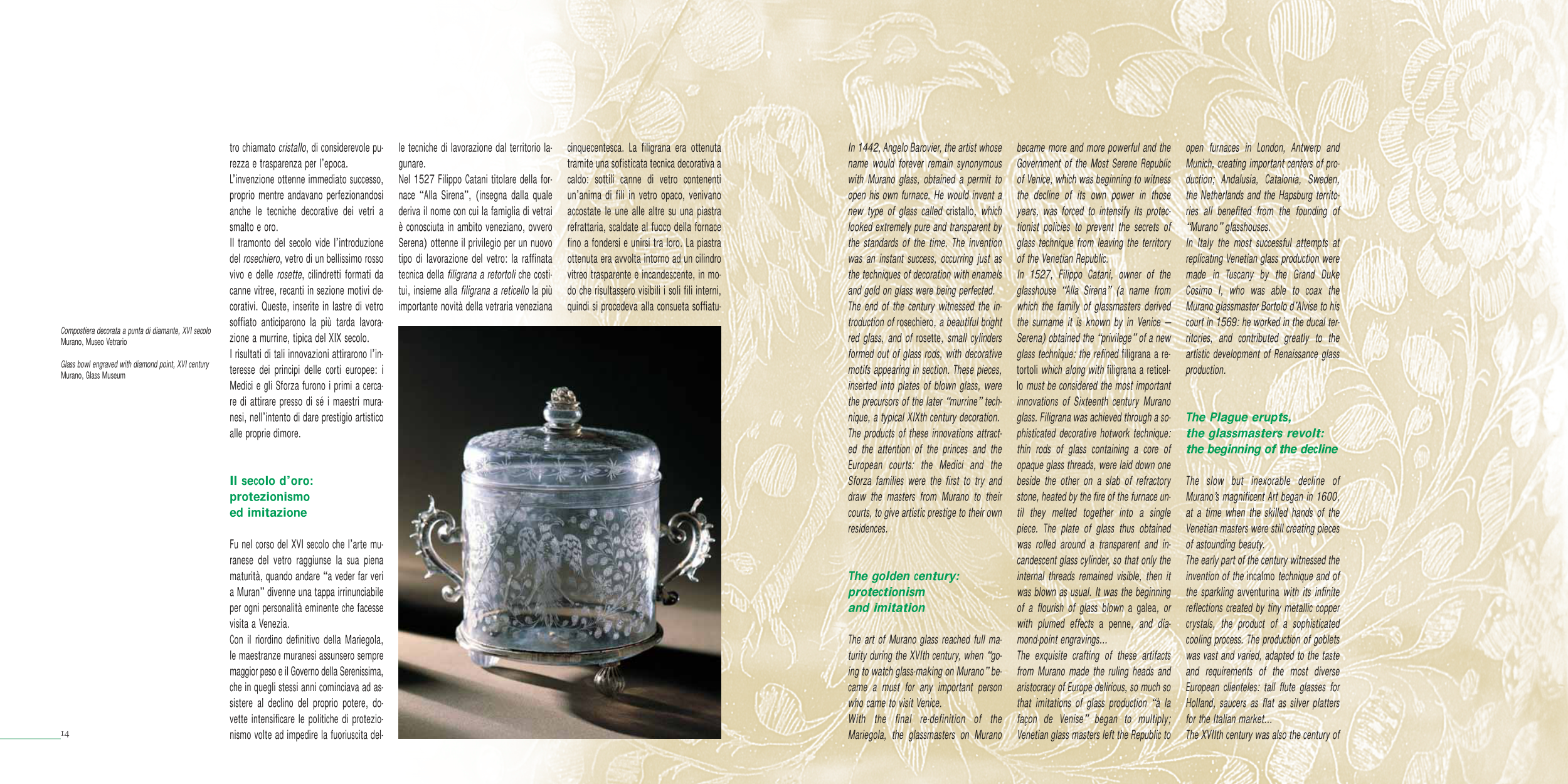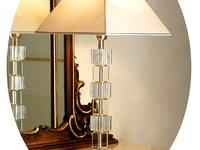In 1442, Angelo Barovier, the artist whose
name would forever remain synonymous
with Murano glass, obtained a permit to
open his own furnace. He would invent a
new type of glass called cristallo, which
looked extremely pure and transparent by
the standards of the time. The invention
was an instant success, occurring just as
the techniques of decoration with enamels
and gold on glass were being perfected.
The end of the century witnessed the in-
troduction of rosechiero, a beautiful bright
red glass, and of rosette, small cylinders
formed out of glass rods, with decorative
motifs appearing in section. These pieces,
inserted into plates of blown glass, were
the precursors of the later “murrine” tech-
nique, a typical XIXth century decoration.
The products of these innovations attract-
ed the attention of the princes and the
European courts: the Medici and the
Sforza families were the first to try and
draw the masters from Murano to their
courts, to give artistic prestige to their own
residences.
The golden century:
protectionism
and imitation
The art of Murano glass reached full ma-
turity during the XVIth century, when “go-
ing to watch glass-making on Murano” be-
came a must for any important person
who came to visit Venice.
With the final re-definition of the
Mariegola, the glassmasters on Murano
became more and more powerful and the
Government of the Most Serene Republic
of Venice, which was beginning to witness
the decline of its own power in those
years, was forced to intensify its protec-
tionist policies to prevent the secrets of
glass technique from leaving the territory
of the Venetian Republic.
In 1527, Filippo Catani, owner of the
glasshouse “Alla Sirena” (a name from
which the family of glassmasters derived
the surname it is known by in Venice –
Serena) obtained the “privilege” of a new
glass technique: the refined filigrana a re-
tortoli which along with filigrana a reticel-
lo must be considered the most important
innovations of Sixteenth century Murano
glass. Filigrana was achieved through a so-
phisticated decorative hotwork technique:
thin rods of glass containing a core of
opaque glass threads, were laid down one
beside the other on a slab of refractory
stone, heated by the fire of the furnace un-
til they melted together into a single
piece. The plate of glass thus obtained
was rolled around a transparent and in-
candescent glass cylinder, so that only the
internal threads remained visible, then it
was blown as usual. It was the beginning
of a flourish of glass blown a galea, or
with plumed effects a penne, and dia-
mond-point engravings...
The exquisite crafting of these artifacts
from Murano made the ruling heads and
aristocracy of Europe delirious, so much so
that imitations of glass production “à la
façon de Venise” began to multiply;
Venetian glass masters left the Republic to
open furnaces in London, Antwerp and
Munich, creating important centers of pro-
duction; Andalusia, Catalonia, Sweden,
the Netherlands and the Hapsburg territo-
ries all benefited from the founding of
“Murano” glasshouses.
In Italy the most successful attempts at
replicating Venetian glass production were
made in Tuscany by the Grand Duke
Cosimo I, who was able to coax the
Murano glassmaster Bortolo d’Alvise to his
court in 1569: he worked in the ducal ter-
ritories, and contributed greatly to the
artistic development of Renaissance glass
production.
The Plague erupts,
the glassmasters revolt:
the beginning of the decline
The slow but inexorable decline of
Murano’s magnificent Art began in 1600,
at a time when the skilled hands of the
Venetian masters were still creating pieces
of astounding beauty.
The early part of the century witnessed the
invention of the incalmo technique and of
the sparkling avventurina with its infinite
reflections created by tiny metallic copper
crystals, the product of a sophisticated
cooling process. The production of goblets
was vast and varied, adapted to the taste
and requirements of the most diverse
European clienteles: tall flute glasses for
Holland, saucers as flat as silver platters
for the Italian market...
The XVIIth century was also the century of
tro chiamato cristallo, di considerevole pu-
rezza e trasparenza per l’epoca.
L’invenzione ottenne immediato successo,
proprio mentre andavano perfezionandosi
anche le tecniche decorative dei vetri a
smalto e oro.
Il tramonto del secolo vide l’introduzione
del rosechiero, vetro di un bellissimo rosso
vivo e delle rosette, cilindretti formati da
canne vitree, recanti in sezione motivi de-
corativi. Queste, inserite in lastre di vetro
soffiato anticiparono la più tarda lavora-
zione a murrine, tipica del XIX secolo.
I risultati di tali innovazioni attirarono l’in-
teresse dei principi delle corti europee: i
Medici e gli Sforza furono i primi a cerca-
re di attirare presso di sé i maestri mura-
nesi, nell’intento di dare prestigio artistico
alle proprie dimore.
Il secolo d’oro:
protezionismo
ed imitazione
Fu nel corso del XVI secolo che l’arte mu-
ranese del vetro raggiunse la sua piena
maturità, quando andare “a veder far veri
a Muran” divenne una tappa irrinunciabile
per ogni personalità eminente che facesse
visita a Venezia.
Con il riordino definitivo della Mariegola,
le maestranze muranesi assunsero sempre
maggior peso e il Governo della Serenissima,
che in quegli stessi anni cominciava ad as-
sistere al declino del proprio potere, do-
vette intensificare le politiche di protezio-
nismo volte ad impedire la fuoriuscita del-
le tecniche di lavorazione dal territorio la-
gunare.
Nel 1527 Filippo Catani titolare della for-
nace “Alla Sirena”, (insegna dalla quale
deriva il nome con cui la famiglia di vetrai
è conosciuta in ambito veneziano, ovvero
Serena) ottenne il privilegio per un nuovo
tipo di lavorazione del vetro: la raffinata
tecnica della filigrana a retortoli che costi-
tuì, insieme alla filigrana a reticello la più
importante novità della vetraria veneziana
cinquecentesca. La filigrana era ottenuta
tramite una sofisticata tecnica decorativa a
caldo: sottili canne di vetro contenenti
un’anima di fili in vetro opaco, venivano
accostate le une alle altre su una piastra
refrattaria, scaldate al fuoco della fornace
fino a fondersi e unirsi tra loro. La piastra
ottenuta era avvolta intorno ad un cilindro
vitreo trasparente e incandescente, in mo-
do che risultassero visibili i soli fili interni,
quindi si procedeva alla consueta soffiatu-
14
Compostiera decorata a punta di diamante, XVI secolo
Murano, Museo Vetrario
Glass bowl engraved with diamond point, XVI century
Murano, Glass Museum







